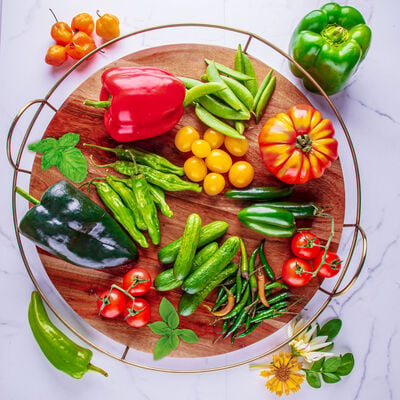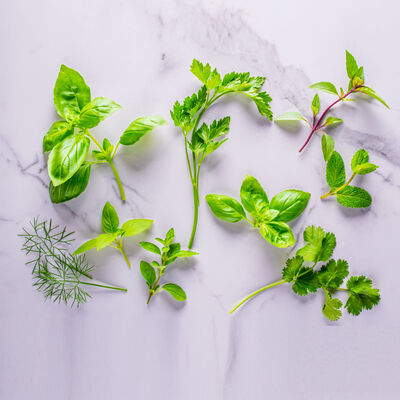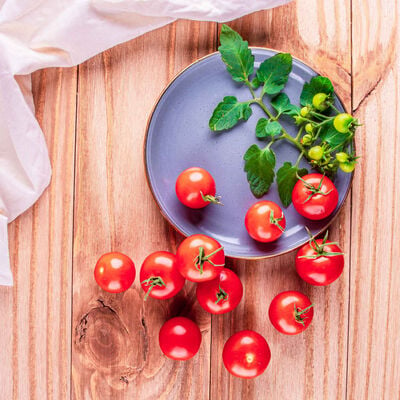
My plants aren't growing/appear unhealthy
Quick tips for healthier plants.
If your seeds germinated but plant growth is stalled or the plants look unhealthy, it's not because they are "defective;" either they are not getting something they need, or they are getting something they don't need. Here's what to check:
Lights
The Grow Lights Hood should be set to the lowest possible position on the Light Post when starting a new seed kit. Many of the Herb and Flower kits contain a mix of seeds that vary in germination times and grow to different heights. It is important to trim the tallest, fastest growing plants from the top so the Light Hood can remain at the lowest position for the shortest, slowest growing plants. This ensures that all plants get the light they need to thrive. Trim no more than 1/3 of any plant at once; just a snip from the top to keep tall plants an inch or two below the lights will do the trick.
CFLs (compact fluorescent lights) should be replaced after six months of use. While they may still appear to be bright, they lose a significant amount of their full-spectrum light over time. A plant's growth depends on getting sufficient energy from two parts of the light spectrum - red and blue - that are invisible to us. Without that energy, they can't flourish.
LEDs (light emitting diodes) are the red, white and blue "pinpoint" lights in the hood, and will last 3-5 years.

Pump/Aerator
The pump or aerator/bubbler in your AeroGarden provides oxygen to the plant roots. If the water is not being aerated, the roots can't send enough oxygen up to the plants, which will then slowly suffocate until finally they collapse. AeroGardens have systems to aerate the water, and it's important to check the pump or aerator periodically to make sure it is working. Fortunately, the plants give weeks of warning that something isn't right before the final collapse. If you are checking the pump or aerator each time you add water or nutrients, any problems can be discovered in time to correct them long before the damage to the plants is irreversible.
AeroGarden Sprout 2020 - Pump Restart Troubleshooting
Nutrients
Add liquid nutrients to the water bowl when planting your seed kit, and every 2 weeks thereafter. There is a feeding chart on each nutrient bottle that shows the correct amount to be added for your AeroGarden model. Adding more or less than the required amount is not recommended.
Nutrients should be in liquid form only, the tablet nutrients have not been produced since 2009. If you are using tablet nutrients, the active ingredients have long since expired and the plants will not receive the food they need to germinate and grow.

Other Possible Causes
If you have checked all of the points above (Lights, Pump/Aerator, Nutrients) but the growth of your plants is stunted, or if their leaves are yellowing or browning, there could be other reasons:
There is a nutrient imbalance in your water. Your nutrient solution can become too strong if there are lots of dissolved minerals in your source water, or if your Seed Kit has been growing a long time without a rinse-and-refill. Nutrient imbalance usually manifests as yellowing of the leaves or browning of leaf edges, and if not corrected can lead to plant death. You can correct this imbalance by doing a Rinse-and-Refill.
Your plants have attracted an insect infestation. If you suspect that you may have insects on your plants, click here for more extensive troubleshooting information.
The water temperature is elevated to 80 degrees or above. If your AeroGarden is located in a sunny window, the water can heat up and oxygen levels in the water bowl can be severely depleted. Move the AeroGarden to a cooler, shadier location.
Your plants have a plant or root disease. Plants grown in the AeroGarden are not immune to the airborne and soil-borne plant diseases that afflict outdoor plants, but because they lead a sheltered life indoors, diseases are much less of a problem. The field of plant pathology is extensive, and short of microscopic examination of plant tissue by an expert it is impossible to diagnose exactly what plant disease may be affecting your plant. However, here are some plant diseases that can affect indoor plants:
- Tobacco Mosaic Virus causes yellow/green mottling of leaves, particularly in tomatoes and peppers. It is found on virtually all tobacco products, including cigarettes and smokeless tobacco, and is carried on the hands and clothing of most smokers. There is no remedy once plants are affected. Tobacco users should not smoke in the vicinity of the plants or handle the plants.
- Powdery Mildew manifests as a gray or white powder on leaf surfaces, which causes leaves to shrink and eventually crumple and dry up. It can affect almost any plant, but particularly enjoys dill. It can be controlled with a sulfur-containing powdery mildew spray, available at most nurseries and garden centers.
- Pythium is a naturally-occurring soil microorganism that can cause root rot. In the soil it is normally kept in check by the other microorganisms, but if inadvertently transferred to an AeroGarden, it can overgrow and cause root rot and plant death. (If you are also a soil gardener and have recently been working in your garden, always remember to wash hands thoroughly to remove any soil residue before working with your AeroGarden.) If your plants suddenly begin to wilt from the bottom up, or the stalk of the plants are pinched at the base, they may be affected by pythium. There is no control measure, and if your plants are wilting from the bottom up, we recommend disposing of all plant material in the trash and completing a very, very thorough sanitizing of your AeroGarden. A rinse and refill, as well as rinsing the roots and never filling above the fill line in the reservoirs should prevent this "root disease" to the Pythium section. (See your Seed Kit instruction booklet for sanitizing instructions, or click here.)



